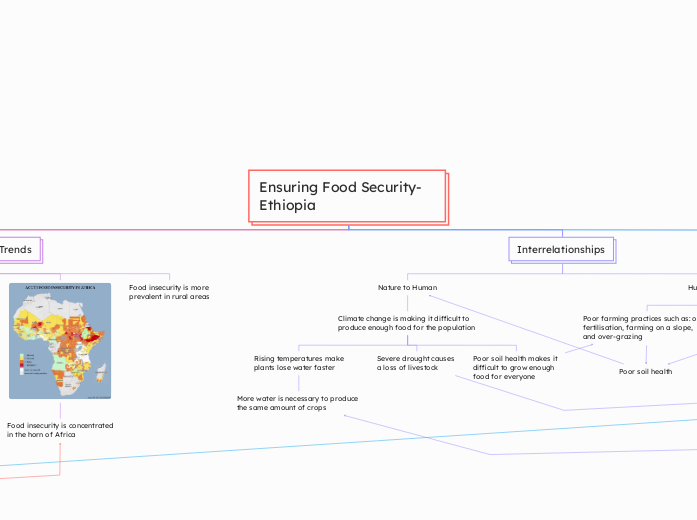Ensuring Food Security- Ethiopia
Spatial Significance
Conflict
The Northern Region experiencing
extreme food insecurity is called Tigray
and it was the site of internal conflict with
militants in Ethiopia in 2021
Food/Aid deliveries by the US & UN to Northern Ethiopa have been suspended due to food theft
Tigray was left in ruins after the conflict
Chronic instability in the Horn of Africa
Relations between Somalia and Ethiopia
are worsening
Patterns and Trends
Food insecurity has increased since 2019
Covid increased food insecurity
The need for food assistance has increased
by 70% since the last food crisis in 2017
Food insecurity is continuing
to increase
Food insecurity is concentrated
in the horn of Africa
Food insecurity is more
prevalent in rural areas
Interrelationships
Nature to Human
Climate change is making it difficult to
produce enough food for the population
Rising temperatures make
plants lose water faster
More water is necessary to produce
the same amount of crops
Severe drought causes
a loss of livestock
Poor soil health makes it
difficult to grow enough
food for everyone
Human to Nature
Poor farming practices such as: over-
fertilisation, farming on a slope,
and over-grazing
Poor soil health
Deforestation is occurring to make
more farmland
Geographic Perspective
Political
Armed conflict: the number of severely
malnourished children entering hospitals doubled when a war broke out between Ethiopa and Eritrea in 2020
Ethiopa houses many refugees and internally displaced people
Economic
Cost of living: rising inflation makes it harder
to afford food
Lack of funding: International support organizations lack enough funding to provide food to all of those that are malnourished in Ethiopa
Environmental
Climate Change has heightened the amount
of droughts and floods in Ethiopia
Severe drought is impacting crop growth making it so enough crops cannot be grown to support the population
